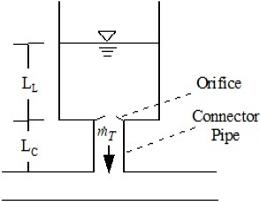Surge Tank Waterhammer Theory
A surge tank is an open tank to the atmosphere (Figure 1) and is used as a surge suppression device (Wylie, et al, 1993Wylie, E.B., V.L. Streeter & L. Suo, Fluid Transients in Systems, Prentice Hall, Englewood Hills, New Jersey, 1993., pp. 128-129).The flow balance on the surge tank junction is similar to a branch junction, with the deficit equaling the flow out of the surge tank, ṁT
Similar to a branch, it can be shown that for all connecting pipes to the junction
where SC and SB are given by Equations 2 and 3 from Branch Waterhammer Theory.

Figure 1: Surge tank schematic
The optional connector pipe and orifice effect is incorporated by the lumped inertia relationship as follows:
where C1 and C2 are defined in conjunction with lumped inertia. Refer to Equation 1 for lumped pipe inertia. The new tank liquid height can be related to the old height by the following:
Substitution yields
Solving for
![]()
This flow rate can be back substituted to obtain the junction pressure and surge tank liquid height.
Surge Tank Vapor Cavitation Theory
Any short-lived vapor cavities that develop at a Surge Tank junction are assumed to have a negligible effect compared to the surge tank itself. Conceptually, vapor bubbles would rise by buoyancy to the surge tank surface and evaporate at the surface.
Therefore, vapor cavitation is ignored at surge tanks.
Related Topics
Related Examples



